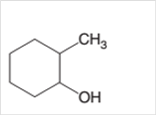
(a)
Interpretation:
The IUPAC name of the following compound needs to be determined:

Concept Introduction:
Organic compounds are the compounds that are mainly composed of C and H atoms. The branch of chemistry that deals with the preparation, reactions, and properties of organic compounds are said to be
The structural formula represents all the bonded atoms with
(b)
Interpretation:
The IUPAC name of the following compound needs to be determined:

Concept Introduction:
Organic compounds are the compounds that are mainly composed of C and H atoms. The branch of chemistry that deals with the preparation, reactions, and properties of organic compounds are said to be organic chemistry. The molecular formula of the organic compound represents the number of bonded atoms with their atomic symbols.
The structural formula represents all the bonded atoms with chemical bonds and the arrangement of atoms in the molecule. IUPAC purposed some rules to determine the name of an organic compound that is based on the number of C atoms in the longest chain of the compound and the name of branches.
(c)
Interpretation:
The IUPAC name of following compound needs to be determined:

Concept Introduction:
Organic compounds are the compounds that are mainly composed of C and H atoms. The branch of chemistry that deals with the preparation, reactions, and properties of organic compounds are said to be organic chemistry. The molecular formula of the organic compound represents the number of bonded atoms with their atomic symbols.
The structural formula represents all the bonded atoms with chemical bonds and the arrangement of atoms in the molecule. IUPAC purposed some rules to determine the name of an organic compound that is based on the number of C atoms in the longest chain of the compound and the name of branches.
(d)
Interpretation:
The IUPAC name of following compound needs to be determined:

Concept Introduction:
Organic compounds are the compounds that are mainly composed of C and H atoms. The branch of chemistry that deals with the preparation, reactions, and properties of organic compounds are said to be organic chemistry. The molecular formula of the organic compound represents the number of bonded atoms with their atomic symbols.
The structural formula represents all the bonded atoms with chemical bonds and the arrangement of atoms in the molecule. IUPAC purposed some rules to determine the name of an organic compound that is based on the number of C atoms in the longest chain of the compound and the name of branches.
Want to see the full answer?
Check out a sample textbook solution
Chapter 14 Solutions
General, Organic, and Biological Chemistry - 4th edition

 Chemistry for Today: General, Organic, and Bioche...ChemistryISBN:9781305960060Author:Spencer L. Seager, Michael R. Slabaugh, Maren S. HansenPublisher:Cengage Learning
Chemistry for Today: General, Organic, and Bioche...ChemistryISBN:9781305960060Author:Spencer L. Seager, Michael R. Slabaugh, Maren S. HansenPublisher:Cengage Learning

